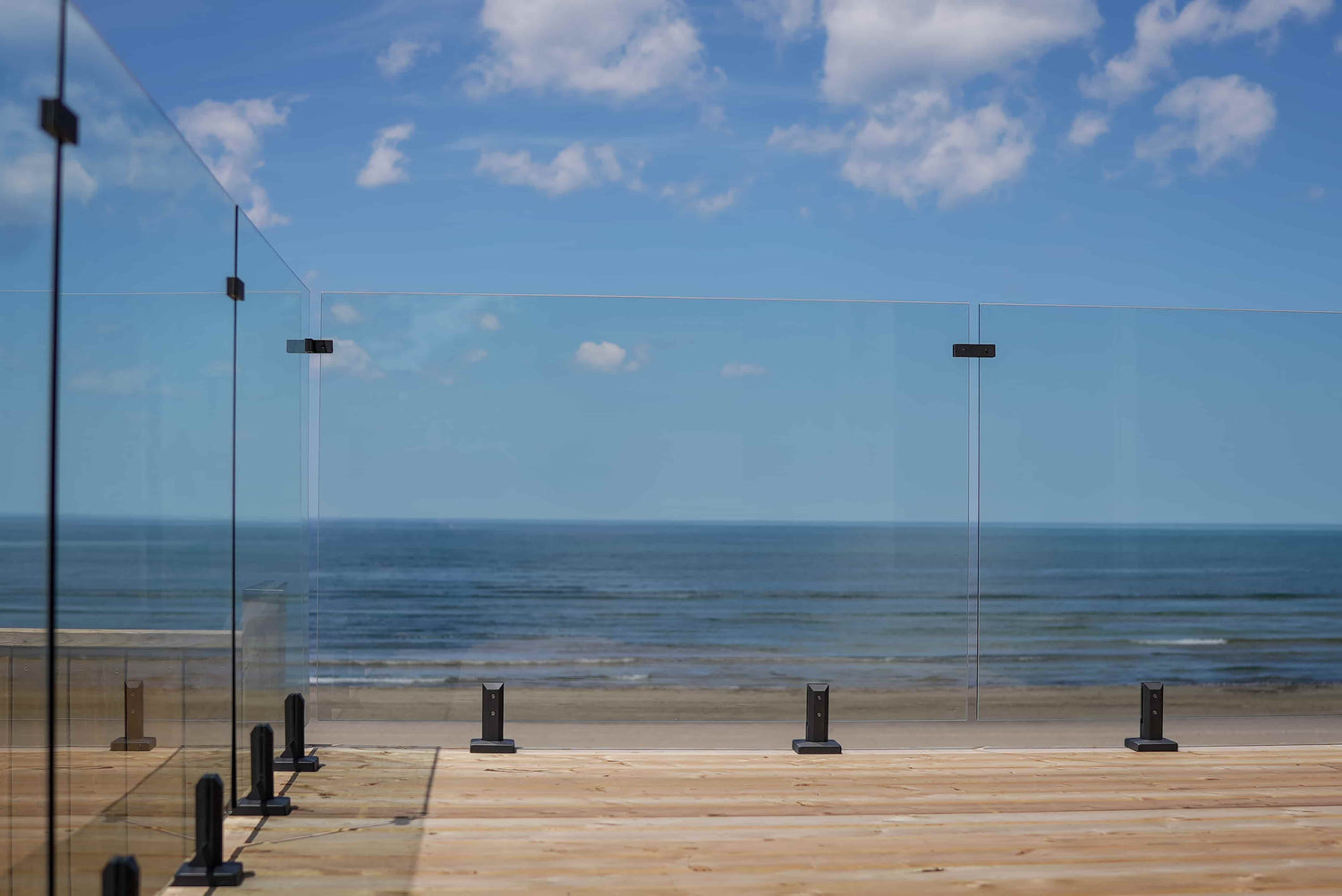Iowa Building Code for Glass Railing

The Iowa Building Code governs glass railing design and installation. This guideline provides glass railing safety regulations without compromising aesthetics.
Likewise, this code specifies details of glass railing requirements, including glass panel and height requirements. Reading this guide should give you an overview of the Iowa Building Code and compliance guidelines for glass railing systems.
Keep reading to learn more!
What is the Iowa Building Code

The Iowa Building Code is a set of safety regulations and compliance guidelines for designing and constructing safe and functional buildings in Iowa. The Iowa Building Code Bureau is responsible for adopting the state’s building code.
The building code in Iowa is based on the 2015 International Building Code (IBC), which came into effect on May 18, 2016, after appropriate additions and amendments. Nonetheless, local jurisdictions within the state are at liberty to either adopt the state building code or approve a stricter option.
The function of Glass Railing Systems

Framed and frameless glass railings are forms of guardrails that have glass panels held by different support structures. Therefore, these railing systems are capable of protecting and providing support for users.
Based on universal building safety compliance guidelines, most elevated platforms and access facilities require railing systems. Examples of indoor and outdoor spaces requiring glass railings include stairways, ramps, terraces, balconies, decks, mezzanines, and other raised platforms.
Glass deck railings and similar guardrails can quickly enhance interior and exterior aesthetics, making these systems appealing. In particular, such railings allow uninterrupted views from city rooftops and vacation home balconies and terraces.
The Iowa Building Code provides specific safety regulations to protect users in all building types. As such, glass railings must adhere to the following requirements.
- Balconies, decks, stairways, ramps, and other platforms elevated more than 762 mm (30 inches) above adjacent walking surfaces must have glass railings or an equivalent guardrail.
- Openings wider than 100 mm (4 inches) are not allowed for framed and frameless glass railings in residential settings. However, industrial occupancies allow for wider openings when required.
Glass Railing Requirements

Glass railing design and deployment are inappropriate without adherence to safety regulations. As such, the Iowa Building Code specifies glass panel and guard railing height based on the best national and international building safety compliance guidelines.
Glass Panel Requirements
Glazing used for framed and frameless glass railings must meet the minimum safety standards, ensuring users are safe while using indoor and outdoor locations. Below are glass panel requirements that ensure guardrail stability and durability.
- All glass panels used for railings in Iowa must comply with Category II of CPSC 16 CFR Part 1201 or Class A of ANSI Z97.1 standard.
- Fully tempered or heat-strengthened glazing is prioritized for all railings, especially those overhead or near locations with foot traffic.
- However, single-tempered glass panels can be used where falling glass does not pose any risk to the public.
- Visible defects, like cracks and dents, can affect glass panel integrity. Glazing with any visible imperfections should not be used in guardrails.
- Frameless glass railings require glass panels to be at least 12 mm (0.5 inches). Yet, thicker glazing may be recommended in locations with heavy foot traffic.
Frameless Glass Railing Height
Frameless glass railings must meet a minimum height requirement as specified by the Iowa Building Code. This requirement makes climbing railings challenging and less likely, especially for children.
Here are some specific frameless glass railing height requirements.
- Glass railings used in public, commercial, and residential buildings should be at least 1067 mm (42 inches) high.
- Individual dwelling homes that do not exceed three stories can have frameless glass railings with a minimum height of 914 mm (36 inches).
- Opensides of stairways for residential houses can have railings that are at least 864 mm (34 inches).
Pool Glass Railing Enclosure
According to the Iowa Building Code, some pools and other recreational water bodies may require fencing. This safety regulation is put in place to prevent unauthorized access to swimming areas, which preserves life by limiting the likelihood of accidental drowning.
If a residential pool, spa, or hot tube is more than 610 mm (24 inches) deep, it must have guardrails with the following specifications.
- Frameless glass railings used for water bodies must have a minimum height of 1219 mm (48 inches).
- Glass panels used in pool enclosure must be at least 12 mm (0.5 inches) or thicker.
- If one or more sides of a pool are enclosed by a wall or building, all doors and windows must always be closed and connected with alarm systems.
- Self-closing and self-latching devices must be attached to all gates leading into the swimming area.
- Just like other railings, glass pool enclosures must not have openings that exceed 100 mm (4 inches) in diameter.
Installation and Maintenance Tips for Frameless Glass Railings

Proper installation and maintenance of frameless glass railings ensure systems always adhere to safety regulations as stipulated in the Iowa Building Code. Therefore, this section provides homeowners and DIYers tips to ensure their guardrails are always in top working condition.
- Ensure the base of your guardrail is level and strong enough to hold the structure and weight of a railing system. You may need to work with a certified mason to achieve a strong base.
- Always strictly adhere to the manufacturer's recommended installation techniques and hardware assembly steps. In addition, always use the appropriate tools for each installation phase. For example, you should get a hold of precision drills, alignment guides, and suction cups during deployment.
- Ensure you double-check measurements on all sections of the railings, as doing this prevents unnecessary gaps and misalignments. Likewise, ensure bolts and fasteners are secure and tightened.
- Strictly adhere to the Iowa Building Code and local safety regulations that may exist.
- Regularly clean glass panels with appropriate cleaning solutions and cloth.
- Periodically conduct hardware checks to ensure spigots, clamps, and brackets are securely in place.
- Immediately take action when you spot a problem with a glass panel or its supporting hardware.
Conclusion
Building safety compliance guidelines are encapsulated in the Iowa Building Code, which is reviewed and adopted by the state Building Code Bureau. This code also guides glass railing design and installation.
When used the right way, the building code provides glass railing requirements, which include glass panel and railing height specifications. In addition, it highlights crucial details required for building frameless glass railing pool enclosures.
Building owners interested in DIY projects can carefully use the design and installation tips highlighted in this article.
FAQs for Iowa Building Code for Glass Railing
What is the minimum height for a glass railing?
Framed and frameless glass railings used for indoor and outdoor use should have a minimum height of 1067 mm (42 inches). However, railings can be as low as 864 mm (34 inches) or 914 mm (36 inches) when used in residential individual dwelling homes.
What is the minimum allowable thickness for glass panels used in railings?
The thickness of frameless glass railings starts at 12 mm (0.5 inches) and can be thicker depending on the use case.
Can I use any safety glasses for railings?
Glass railings should only have fully tempered or heat-strengthened glass panels that comply with Category II of CPSC 16 CFR Part 1201 or Class A of ANSI Z97.1 standard.
Let customers speak for us

Glass Railing Near You
Discover how The Glass Railing Store has been delivering exceptional service to our customers, thanks to our dedicated and knowledgeable team and their love our glass railing products.







